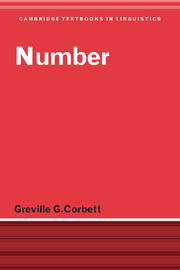Book contents
- Frontmatter
- Contents
- List of figures
- List of tables
- Preface
- List of abbreviations
- 1 Introduction
- 2 Meaning distinctions
- 3 Items involved in the nominal number system
- 4 Integrating number values and the Animacy Hierarchy
- 5 The expression of number
- 6 The syntax of number
- 7 Other uses of number
- 8 Verbal number
- 9 Conclusion and new challenges
- References
- Author index
- Language index
- Subject index
7 - Other uses of number
Published online by Cambridge University Press: 05 June 2012
- Frontmatter
- Contents
- List of figures
- List of tables
- Preface
- List of abbreviations
- 1 Introduction
- 2 Meaning distinctions
- 3 Items involved in the nominal number system
- 4 Integrating number values and the Animacy Hierarchy
- 5 The expression of number
- 6 The syntax of number
- 7 Other uses of number
- 8 Verbal number
- 9 Conclusion and new challenges
- References
- Author index
- Language index
- Subject index
Summary
We have considered the meanings regularly associated with the different values (plural, dual, paucal and so on). We now come to other uses of number, that is, instances where the regular expression of number is taken over for purposes other than its normal meaning. For instance, in honorific usage, plural forms are often used of a single addressee to indicate respect. The semantic and pragmatic effects of number in such uses cannot be derived in the normal way from the usual meanings of the number values. Given that number is often cited as a straightforward grammatical category, apparently reflecting semantics in a regular way, these other uses are found surprisingly frequently. They occur even in familiar languages: we shall see cases where a particular use identified in some distant language turns out to be rather frequent closer to home.
There are three broad groups of these other uses: first there are honorific uses (§7.1), as just mentioned; second there are unexpected uses in the general area of conjoining (§7.2); and finally there are various special uses, affective ones in the main (§7.3). In analysing these uses, there are three questions which will recur. The first is whether all number values are available for the particular use; often there are restrictions, and for affective use it is never the case that all values are available. The second is why these uses can be available, particularly since number frequently is a relatively clear reflection of semantics.
- Type
- Chapter
- Information
- Number , pp. 219 - 242Publisher: Cambridge University PressPrint publication year: 2000



